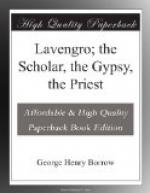‘Well,’ said I, ‘and what did the orators say?’
‘They gazed dubiously at me and at one another,’ said my brother; ’at last the watchmaker asked me who this Mr. Christo was; adding, that he had never heard of such a person; that, from my recommendation of him, he had no doubt that he was a very clever man; but that they should like to know something more about him before giving the commission to him. That he had heard of Christie the great auctioneer, who was considered to be an excellent judge of pictures; but he supposed that I scarcely—Whereupon, interrupting the watchmaker, I told him that I alluded neither to Christo nor to Christie; but to the painter of Lazarus rising from the grave, a painter under whom I had myself studied during some months that I had spent in London, and to whom I was indebted for much connected with the heroic.
’"I have heard of him,” said the watchmaker, “and his paintings too; but I am afraid that he is not exactly the gentleman by whom our mayor would wish to be painted. I have heard say that he is not a very good friend to Church and State. Come, young man,” he added, “it appears to me that you are too modest; I like your style of painting, so do we all, and—why should I mince the matter?—the money is to be collected in the town, why should it go into a stranger’s pocket, and be spent in London?”
’Thereupon I made them a speech, in which I said that art had nothing to do with Church and State, at least with English Church and State, which had never encouraged it; and that, though Church and State were doubtless very fine things, a man might be a very good artist who cared not a straw for either. I then made use of some more Greek words, and told them how painting was one of the Nine Muses, and one of the most independent creatures alive, inspiring whom she pleased, and asking leave of nobody; that




